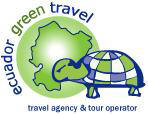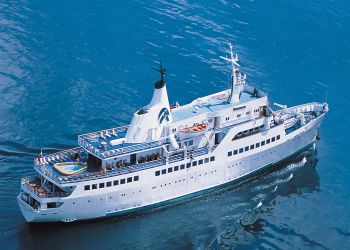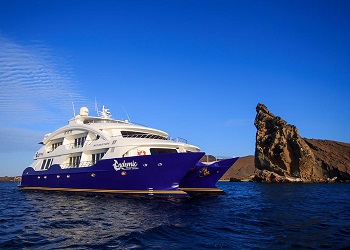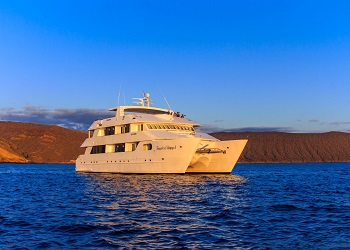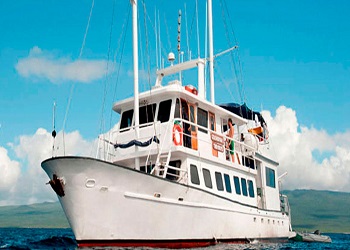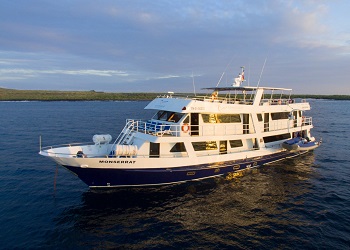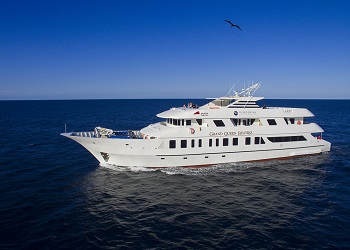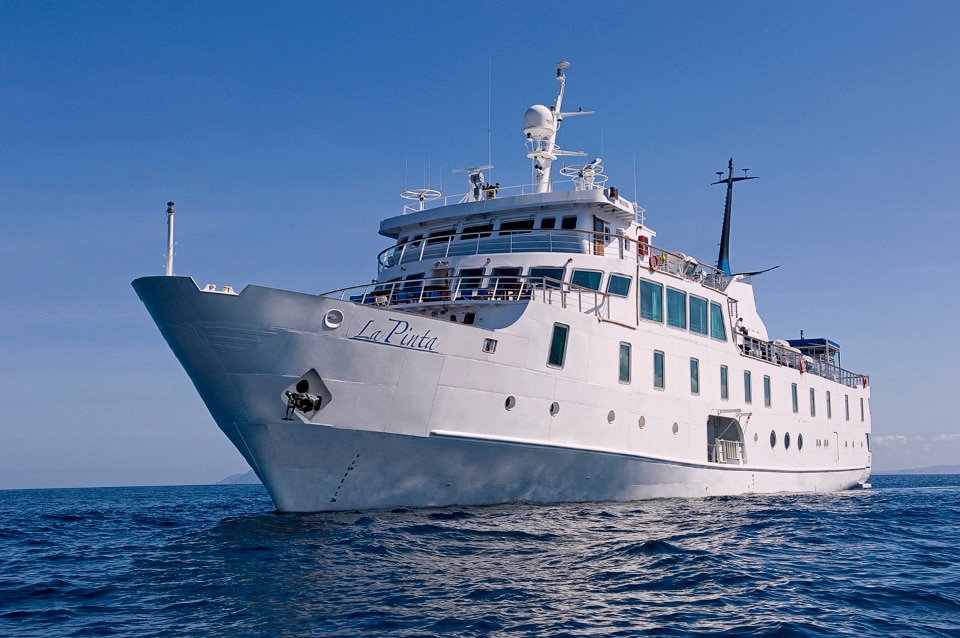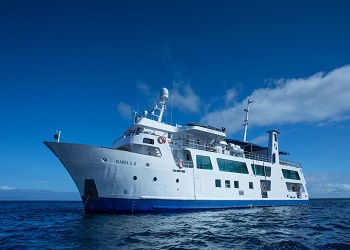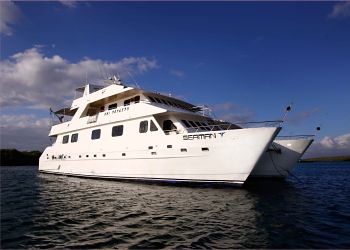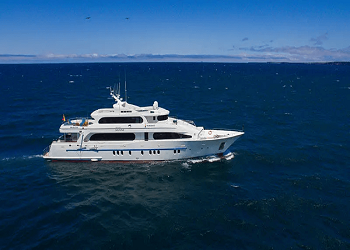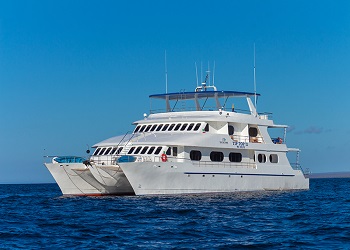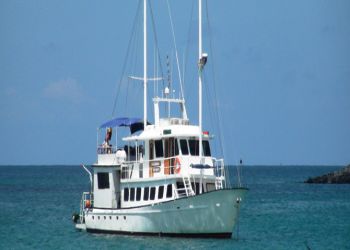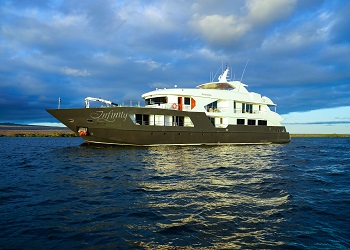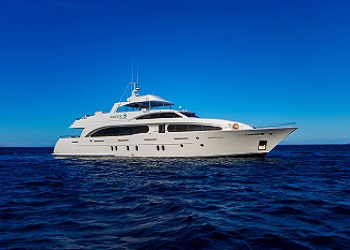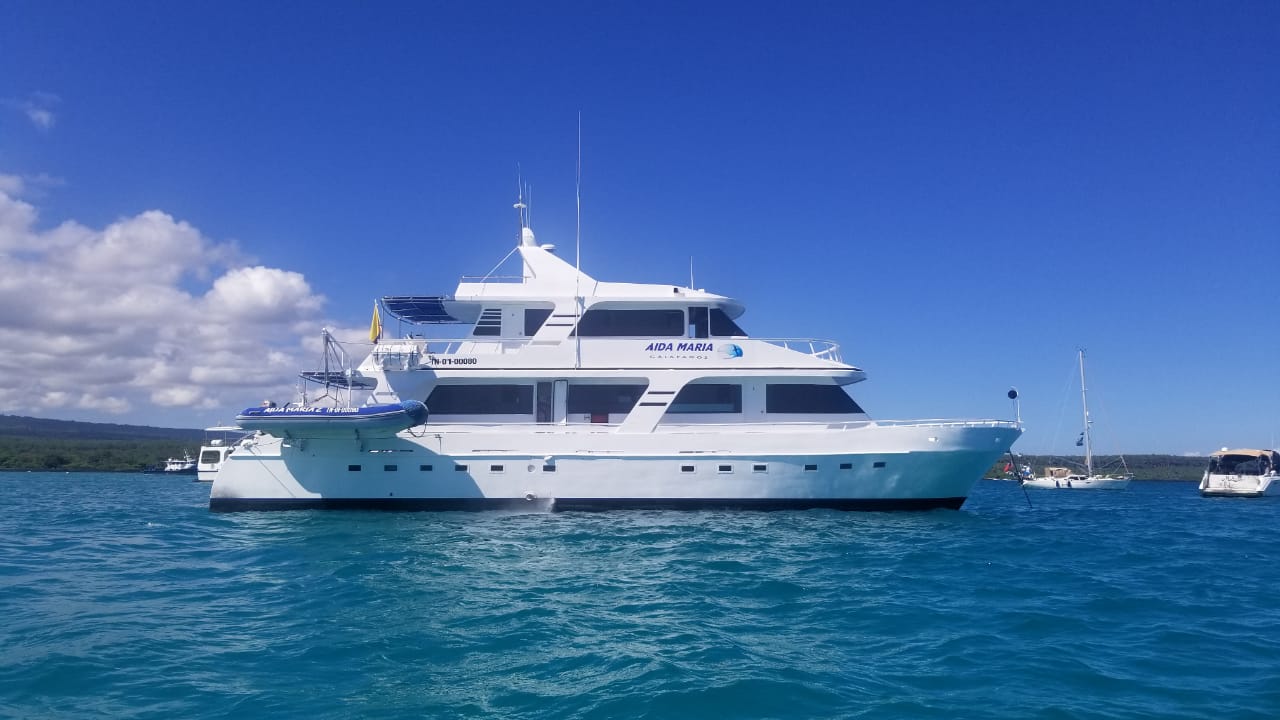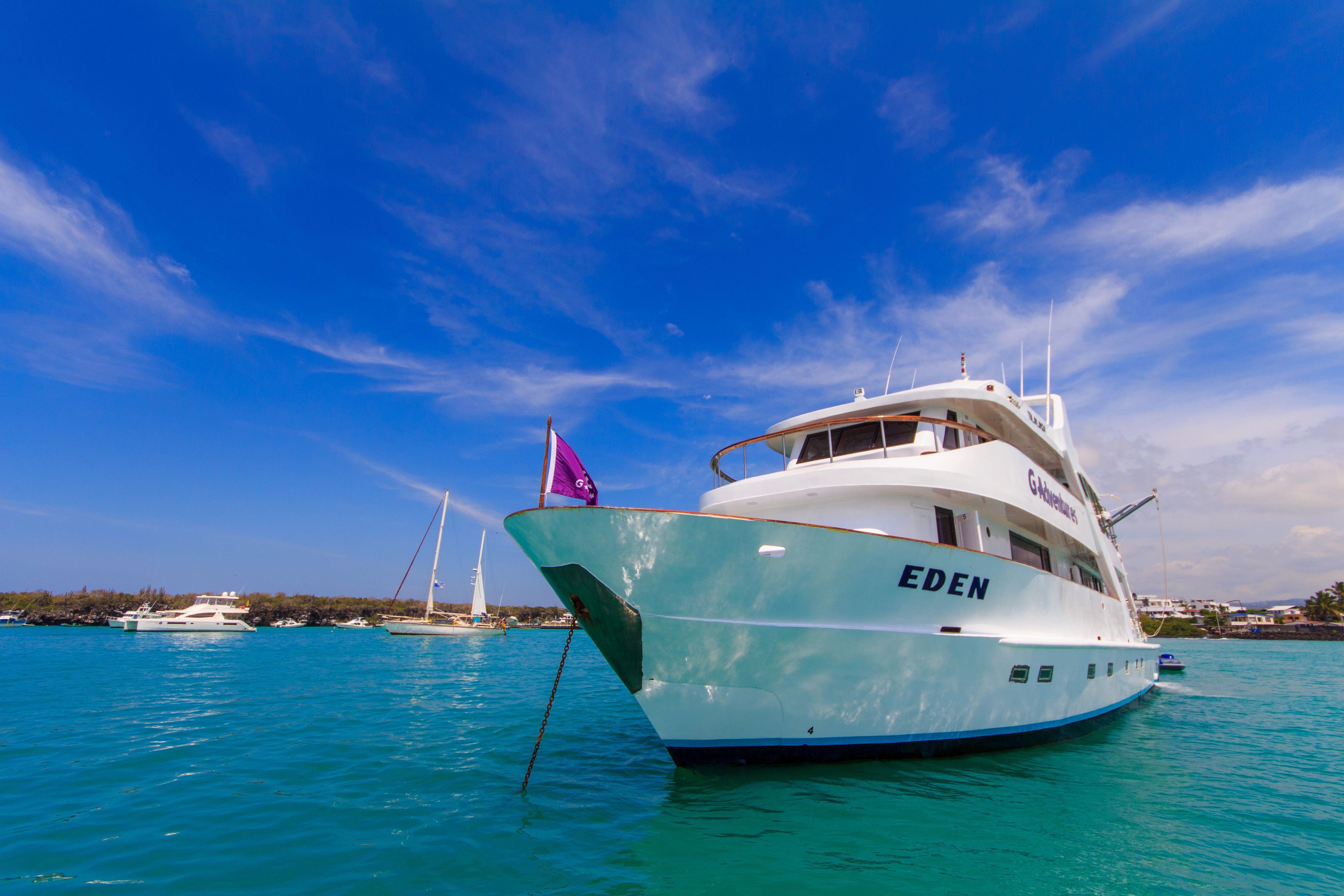Our 6-night western itinerary primarily explores the remote and exclusive western islands of Isabela and pristine Fernandina, which are both just recently born out of the fire. After navigating around Isabela we will return to the heart of the archipelago for several
landings at Santiago and its satellite islets, before finishing on and around Santa Cruz. This cruise itinerary includes two nights of quiet rest at fairly calm anchorage sites.
ROUTE
DAY 1: TUESDAY
AM: Arrival at Baltra Airport
Upon arrival at Baltra airport, you will pass through an airport inspection point to ensure that no foreign plants or animals are introduced to the islands, as well as to pay the park entrance fee of USD 100 (unless it has been prepaid). A guide will meet you, help you collect your luggage, and escort you on a short bus ride to the harbour. Here you will climb aboard the yacht Solaris. After greeting the crew and the captain, your cabins will be assigned to you and then you will enjoy your first lunch aboard.
PM: Bachas (Santa Cruz)
These two small beaches are found to the west of Turtle Cove. Their sand is made of decomposed coral, which makes it white and soft, making it a favourite nesting site for sea turtles. There is a small brackish water lagoon behind one of the beaches, where occasionally it is possible to observe flamingos and other coastal birds, such as black-necked stilts and whimbrels. The other beach is longer, but it has two old barges that were abandoned during the Second World War when the USA used Baltra Island as a strategic point to protect the Panama Channel.

DAY 2: WEDNESDAY
AM: Tintoreras (Isabela)
Tintoreras consists of several small islets off the coast of Puerto Villamil and is one of the most emblematic visitor’s sites of the Galapagos. Its impressive concentration of Galapagos wildlife can be admired easily during the tour From a viewpoint, you can see herons on mangrove branches whilst Galapagos penguins and sea lions can be spotted on the land. Whitetip reef sharks can be found in the tidal channels, and their abundance is what gives these islets their Spanish name. Another highlight is the breeding colony with uncountable numbers of marine iguanas!

PM: Wetlands, Wall of Tears and tortoise breeding centre (Isabela)
After lunch aboard, you will visit the local tortoise breeding centre, where you can see hundreds of giant Galapagos tortoises of all sizes. The vulnerable hatchlings are not gigantic at all, even smaller than the size of your hand! This project, just outside Puerto Villamil, was created to rescue the endangered populations of Isabela’s southernmost volcanoes. In Puerto Villamil and the surrounding wetlands, there is the historical site called “The Wall of tears”, a national cultural heritage place where punished prisoners were forced to build this long wall and useless wall of lava rocks. Also, you might have the chance to see American flamingos. At the end of the afternoon, you will have some free time to explore the village and/or its beach.

DAY 3: THURSDAY
AM: Moreno Point (Isabela)
Moreno Point is located on the north coast of Isabela Island, between the volcanos Sierra Negra and Cerro Azul. The trail runs along a solidified pahoehoe lava flow into a complex of coastal lagoons. Its main attractions are several species of birds, which are found around the lakes and mangrove forests.

PM: Punta Mangle (Fernandina), Tagus Cove (Isabela)
You will enter the Bolivar Channel and navigate towards Tagus Cove. On the way, you will see how explosive eruptions have blown out a part of the outer rims of both tuff cones, and created their characteristic horseshoe shapes and Tagus Cove. Sailors used to write the names of their vessels on the eastern cliffs of this place. A tour along the cliffs in a dinghy will give the visitors a good chance to see the Galapagos penguin, the flightless cormorant and other sea birds. From the landing dock, it is about a 30-minute hike along the trail up to the top of the cliff from where you can view Darwin Lake; an uplifted ultra saline lake saltier than the sea. You can also see several volcanoes from this location. Look carefully at the graffiti on the surrounding cliffs of the cove! They were written by pirates, whalers and buccaneers in past centuries.

DAY 4 - FRIDAY
AM: Punta Espinoza (Fernandina)
Fernandina is the third-largest island in the archipelago and has a single visitor site: Punta Espinoza, located at the northeastern tip of the island. Marine iguanas conglomerate in larger groups than on any other island. They bask around in the sand, swim near the shore and sometimes block the way at the landing dock. Among the unique species found here, is the flightless cormorant. This bird had to adjust its way of survival and perfect its skills of finding food in the ocean. Their wings, tails and feet progressively adapted for swimming. To see these birds is to witness evolution happening right in front of you.\

PM: Punta Vicente Roca (Isabela)
Whilst having lunch, the yacht will cross the Bolivar Channel for the last time to Vicente Roca Point, just at the mouth of Isabela’s seahorse shape. While entering a dark cave below a spectacular arch, the roaring echoes of the waves will accompany you. Just around the corner, the collapsed amphitheatre of Ecuador Volcano offers another impressive view. The calmer waters of the coves are well protected against the ocean swell and are a fairly cold but great place for snorkelling amongst various species of shark, penguins, pufferfish and even seahorses!

DAY 5 - SATURDAY
AM - Espumilla Beach, Bucaneer Cove (Santiago)
Espumilla Beach is a visitor’s site at the northern end of James Bay, on the western coast of Santiago. This beach has been revived as an important breeding site for turtles, as it is no longer suffering from digging wild pigs. The turtles return year after year to bury their eggs into the cinnamon-coloured sand dunes. The beach ridge hides mangroves with two picturesque lagoons. The colony of American flamingos and aquatic birds used to be its main attraction, but after the climate phenomenon of El Niño, strong sedimentation altered the brackish water environment and it no longer contains their food. During the climb of a hill, you will be rewarded with a beautiful overview of the transitions from sea into beach into mangrove into dry palo santo forest.

PM - Puerto Egas (Santiago)
At lunchtime, you will navigate south to Puerto Egas, with its famous fur seal grottos, where you will enjoy another, very different guided walk along the coastline. Its masterfully sculptured coastline of black basalts and polished multi-coloured ash layers forms a photogenic scene with collapsed lava tunnels, natural arches, caves and blowholes such as “Darwin’s toilet”. In a grotto directly below a spectacular rock arch at the end of the beach, a colony of sea lions occupies the shade. Hundreds of sally lightfoot crabs seem even brighter orange against the black rocks.

DAY 6: SUNDAY
AM: Rabida
After lunch and a “wet landing” on the remarkable red beach of Rabida, there are two short guided hikes. Oxidised iron particles give the rocks and sand their rusty colour. The beach wall holds a shallow green-fringed lagoon. This oasis is the most fertile place on the otherwise arid islet, which is overgrown with leaf-dropping palo santo trees. The salty pool attracts all kinds of aquatic birds, like pintails and sometimes American flamingos. Between the evergreen foliage of the surrounding mangrove bushes, many species of songbirds hide and breed. One of the most outstanding attractions is the major breeding colony of brown pelicans; the only ones in the world that plunge-dive.
PM: Chinese Hat
Chinese Hat is a 52 m/170 ft high volcanic cone, forming an islet off the rocky coast of Santiago, where a small colony of Galapagos penguins has settled. Because its primordial fire has been extinguished recently, this is an excellent place to learn more about volcanism, lava bombs and lava tunnels. On the beach, you can also find curious pillow-type lavas with coral heads on top! These spheres had a submarine origin before being lifted above sea level. Beaches of white coral sand grow, and holes in the eroding lava fields are filled up with lava sand, which enables rooting. Galapagos sea lions and countless marine iguanas contribute to fertilisation. This all together creates more favourable options for newcomers, like saltbush and the discolouring sesuvium carpet.

DAY 7: MONDAY
AM: Charles Darwin Research Station (Santa Cruz) and transfer to Baltra airport
The dinghies will bring you to the touristic pier of Puerto Ayora, from where you will be brought to the Charles Darwin Research Station and the headquarters of the Galapagos National Park Service, from which biological research and indispensable conservation management of this unique but vulnerable archipelago are directed. You will be taken on an educational stroll where your most memorable visit will be that of the successful breeding centre and the enclosure of the Galapagos giant tortoises.
After that, it is time to say goodbye to the Galapagos! It has been a pleasure accompanying you on this unique trip and we hope to see you again very soon. Assisted by the naturalist guide and some crew members, the dinghy will bring you and your luggage to the pier, where you will take the shuttle back to the airport. In case you have booked your trip for a longer stay with us, we would be welcoming any potential new fellow passengers to the yacht, and continue our trip to the next visiting site!

